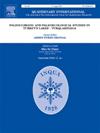Effects of Lateglacial and Holocene climate change on southern Baltic environments: a plant sedaDNA and diatom sediment record
IF 1.8
3区 地球科学
Q3 GEOGRAPHY, PHYSICAL
引用次数: 0
Abstract
We combined multiproxy analyses of plant sedaDNA, diatom, and lithological data from two sediment cores to develop an uninterrupted Lateglacial and Holocene record from the Dūkštelis palaeolake, eastern Lithuania, and compared our findings to published pollen records. SedaDNA provides localised and taxonomically detailed insights into vegetation, surpassing the resolution of pollen data; however, its composition is strongly influenced by aquatic plants, a fact which limits the representation of terrestrial flora to some extent. Macrophyte sedaDNA and diatom data record shifts in lake productivity and water levels, while pollen data reflect a broader regional vegetation context, highlighting the complementarity of these methods.
Subalpine and lowland vegetation colonised the region during the Lateglacial. The presence of shrub taxa, like Arctostaphylos uva-ursi and Arctous alpina with colder-adapted species, like Dryadoideae and Pyrola, and herbs characteristic of lowlands in modern environments, like Trifoliaceae, Mentheae, Ranunculaceae, and Plantago, suggests an open but heterogenous environment with diverse microhabitats created under quickly changing geomorphological conditions. A gradual shift to a forested landscape began with the advent of riparian species like Alnus (∼11300 cal yr BP), Viburnum (∼10300–9200 cal yr BP), and deciduous trees including Ulmaceae, Tilia, and Fagaceae from ∼11150, 10000, and 9900 cal yr BP, respectively. Early to Middle Holocene diatom and macrophyte data show that by ∼10000 cal yr BP, the lake had shifted from a shallow mesotrophic-eutrophic state to a deeper eutrophic system. During the Middle to Late Holocene, sedaDNA data suggest a decline in forest vegetation as the lake evolved into a shallow wetland. At this stage, sedaDNA overrepresents species growing directly in and around the lake, and therefore potentially skewing the broader regional picture. In contrast, pollen data suggest a pronounced forest decline from ∼3300 cal yr BP, likely linked to human activities such as forest clearance, which would increasingly shape the landscape from the Middle Holocene. Notable agricultural and pastoral impacts are indicated by the presence of species such as Avena, Brassicaceae, Plantago, and Trifolium starting ∼3700 cal yr BP.
冰川和全新世气候变化对波罗的海南部环境的影响:植物sedna和硅藻沉积记录
我们结合了来自两个沉积物岩心的植物sedaDNA、硅藻和岩性数据的多代理分析,从立陶宛东部Dūkštelis古湖泊中建立了一个不间断的冰川和全新世记录,并将我们的发现与已发表的花粉记录进行了比较。SedaDNA提供了对植被的局部和分类学详细见解,超过了花粉数据的分辨率;然而,其组成受到水生植物的强烈影响,这在一定程度上限制了陆生植物群的代表性。大型植物sedaDNA和硅藻数据记录了湖泊生产力和水位的变化,而花粉数据反映了更广泛的区域植被背景,突出了这些方法的互补性。在冰河时期,亚高山和低地植被遍布该地区。灌木类群的存在,如熊熊树属和高山树属,以及适应寒冷的树科和鹿蹄草属,以及具有现代低地特征的草本植物,如三叶草科、薄荷科、毛茛科和车前草,表明在快速变化的地貌条件下,形成了一个开放但异质性的环境,具有多样化的微栖息地。随着沿岸物种如桤木(~ 11300 cal yr BP)、Viburnum (~ 10300-9200 cal yr BP)和落叶树(分别来自~ 11150、10000和9900 cal yr BP)的出现,逐渐向森林景观转变。早至中全新世硅藻和大型植物资料表明,到10000 calyr BP,湖泊已从浅层中营养化-富营养化状态转变为深层富营养化系统。在全新世中晚期,sedaDNA数据表明,随着湖泊演变为浅层湿地,森林植被减少。在这个阶段,sedaDNA过度代表了直接在湖中和周围生长的物种,因此可能会扭曲更广泛的区域图景。相比之下,花粉数据表明,从3300 cal yr BP开始,森林明显减少,这可能与人类活动有关,如森林砍伐,这将从全新世中期开始逐渐塑造景观。从距今约3700 cal yr BP开始,Avena、芸苔科、车前草和三叶草等物种的存在表明了显著的农业和畜牧业影响。
本文章由计算机程序翻译,如有差异,请以英文原文为准。
求助全文
约1分钟内获得全文
求助全文
来源期刊

Quaternary International
地学-地球科学综合
CiteScore
5.60
自引率
4.50%
发文量
336
审稿时长
3 months
期刊介绍:
Quaternary International is the official journal of the International Union for Quaternary Research. The objectives are to publish a high quality scientific journal under the auspices of the premier Quaternary association that reflects the interdisciplinary nature of INQUA and records recent advances in Quaternary science that appeal to a wide audience.
This series will encompass all the full spectrum of the physical and natural sciences that are commonly employed in solving Quaternary problems. The policy is to publish peer refereed collected research papers from symposia, workshops and meetings sponsored by INQUA. In addition, other organizations may request publication of their collected works pertaining to the Quaternary.
 求助内容:
求助内容: 应助结果提醒方式:
应助结果提醒方式:


